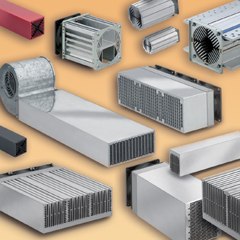
In recent times, there have been many innovations in the semiconductor industry, and important developments have taken place, especially in the field of power semiconductors and IGBT technology. The higher power rating and the improved efficiency are particularly remarkable. These developments, however, have not affected the size of the components which still have a compact design. For the user, the combination of high efficiency and small space requirement is very desirable. However, the electronics engineer has to deal with the problem of how to dissipate the large amount of waste heat. This problem has to be solved by the manufacturers of cooling elements. It is up to them to develop and propose suitable methods.
Ideally there should be co-operation between manufacturers of semiconductor components and manufacturers of cooling elements, in order to create the most appropriate methods. In view of the rapid progress in the field of semiconductor technology, however, this is unlikely, and the onus of finding suitable solutions will lie with users. There are many types of effective heatsinks, cooling systems etc.. The well-known high-capacity aluminium heatsink used for free convection has been further improved. The use of serrated fins has increased their efficiency by 10 to 15 per cent compared to those with conventional fin geometry. A thicker base plate (heatsink bottom) ensures better heat distribution within the entire heatsink. However, there are physical limits to further improvements. So-called superpower heatsinks for free convection are being developed but details have yet to be published. Since methods using cooling systems are much more efficient than those using heatsinks for free convection, they are becoming the preferred solution in cases having high heat dissipation requirements. As far as cooling systems are concerned, a higher efficiency may be achieved by further refinement of the heat exchange surfaces and by using stronger fans.
The heat transfer towards the flowing air that can be achieved with plain fins is relatively restricted. The laminar air flow that emerges is not sufficient to carry off the heat. Therefore, attempts are being made to improve heat transfer (fins to air) by producing more turbulent flow using an appropriate fin geometry. Serrated fins are a first step towards this goal. Further improvements are possible by providing hollow fins and fins with additional cut-outs (so-called cross-stamped fins). The enlarged heat exchange surface and the increased air turbulence lead to a significant improvement in heat dissipation.
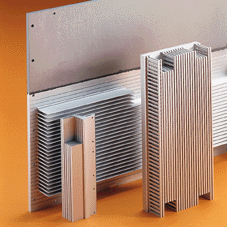
With higher turbulence, however, the pressure in the cooling system acting against the air flow, which is known as dynamic pressure, is also increased. This gives rise to the problem encountered by manufacturers of fans. In case of a large heat exchanging surface which would be suitable for the required dissipation of waste heat, the air flow is insufficient. Axial fans are a simple, compact, low-noise and low-cost solution, whereas their working pressure, however, is relatively low. In contrast, radial fans provide high pressures and volume flows, but they are often too large, too expensive and too noisy.
To propose efficient solutions at reasonable cost, FISCHER ELEKTRONIK have designed a new type of cooling system with hollow fins and specially adapted high-performance axial flow fans. This concept achieves an optimum cost/performance ratio. The new design is available in various forms and may be considered as the most efficient and modern design in the field of cooling systems.
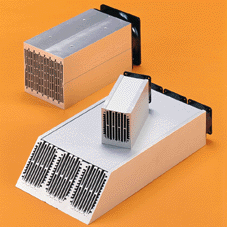
completely different method of cooling components is omnidirectional air cooling. In this case, an existing air flow is effectively utilised e. g. in a control cubicle equipped with ventilators. This solution gives a significant improvement in the performance of the specially designed heatsink, even with the slightest flow of air. The air is not forced in one direction and instead flows around the projecting square "fin pins" of the cooling aggregate. The air then becomes slightly turbulent and carries off the heat. Depending on the size and shape of the heatsink and the speed of air flow, considerable amounts of heat can be carried off.
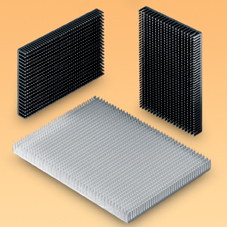
This method may be used to improve almost every cooling profile, thereby achieving better heat dissipation.
Fluid coolers using water, oil, alcohol or gas form the next higher class of cooling systems. This solution is today's highest performance heat dissipation solution. Other than conventional simple concepts, the model developed by FISCHER ELEKTRONIK use an optimum heat exchange surface with the fluid. Thanks to this concept, large amounts of heat can be carried into a fluid that has been made turbulent, using only low dynamic pressure. This method is flexible and can be easily adapted to suit customers' specific requirements.
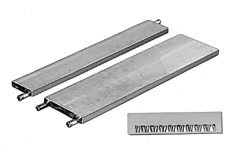
The extremely high power density of electronic components of the new generation, also reveals limits to heat dissipation. One or more components with high dissipation form so-called heat nests: the heat flow from the relatively small component surface to the cooling system and from the cooling system to the environment is limited. This is due to the specific heat dissipation efficiency of aluminium. The actual amount of heat generated exceeds that which can be physically transported with the material. Where this is the case, a thicker base plate for the heatsink helps in absorbing and dissipating a higher amount of heat. In case of time-dependent (transient) cycles of heat input, the larger mass of the cooling device allows "temporary storage" of the heat and dissipation later, when less heat or no heat at all is generated. The simplest way to reduce the problem of heat nests would be to use copper instead of aluminium for cooling systems. This, however, would mean a higher price and three times the weight.
A better and more efficient alternative would be to distribute the heat over several cooling systems or to distribute it more effectively within the heatsink. This method, however, requires a suitable means of transferring the heat from the hot zone to appropriate cooling areas. Heat pipes are well-suited for this purpose. The heat pipe itself is a simple component consisting of an evacuated pipe, filled with a small amount of fluid serving as a medium. When heat is applied to the pipe, the fluid vaporises and generates a temperature gradient in the pipe. This causes the vapour inside the pipe to flow towards the colder area where it condenses and dissipates its latent heat. The fluid then returns to the vaporisation point by means of gravity and / or by capillary action. There are two possible configurations, either a heat-dissipating component as heat source and a suitable cooling system as heatsink, or a heat-dissipating component as heat source and the colder area of the cooling system as heatsink. Both of these involve heat distribution. In view of the low cost of material and labour of heat pipes, this solution is increasingly favoured in the field of cooling systems. This concept has already been introduced for small-sized systems, particularly for the cooling of processor ICs, but large-scale systems are still quite rare. The large amount of heat concentrated on the small area of a processor IC is a challenge with respect to cooling, especially when the use of fans is inappropriate because of the known problems. In this case, heat pipes are suited to transfer the heat from the IC to the heatsink which may be positioned in a thermally suitable place. Another possibility is to use heat pipes to transmit the heat to the case or part of the case, e.g. of a portable computer, which will then act as a heat sinking device.
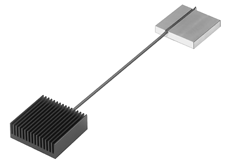
These methods and developments mark the beginning of a new era in the field of cooling technology. In addition to new and improved methods, customised solutions are required rather than standard designs. There is an increasing demand for innovative solutions to specific problems and integrated concepts which anticipate future developments. Co-operation with both customers and users is essential for the success in introducing these methods to the market.





